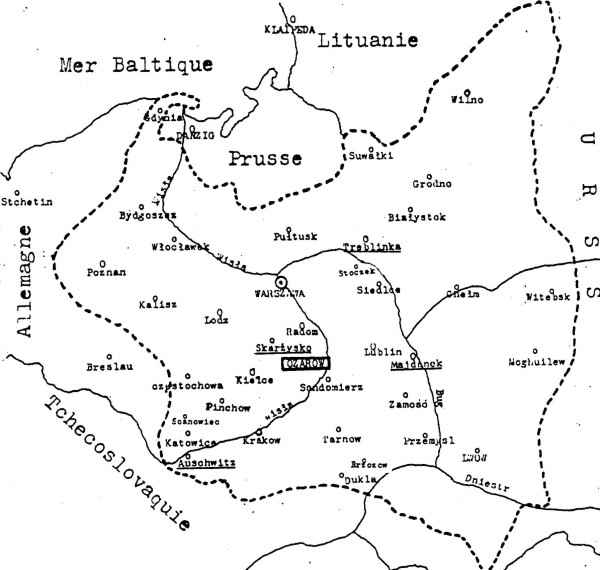 |
|
|
[Page 1]
[Page 2]
|
|
| Map of Poland drawn by the author showing its pre-war boundaries and location of Ozarow |
Ozarow is located in the southeast of Poland, 15 kilometres from the Vistula. It is about eighty kilometres from Kielce and Radom. To the northeast lies the city of Radom, and 200 kilometres to the north is Warsaw, the capital. The region includes wooded and cultivated terrain, and picturesque small hills that extend to the mountain “Swietokrzyska”, the Holy Cross.
The region has a continental climate. In summer the days are clear and sunny, and the nights cool. Thunderstorms and lightening often precede short rainfalls and the rainbows that herald good weather. The temperature ranges between 18 degrees and 35 degrees Celsius.
With autumn and the festival of Succoth come the rains. During this period people lay in provisions for the winter.
Winter comes in December. The days are much shorter and the cold is at its fiercest, often reaching minus 25 degrees. The Vistula freezes over and at certain spots the horses and their sleds were able to cross with all of the weight of the cargo they carried. The snow and cold would make your teeth chatter.
The traditional carts were transformed into horse-drawn sleds with jingling bells to trace their passage. The favourite amusement of the children was to fly down from the top of the Zawiechost Road or that of the narrow road leading to the station in their little sleighs. They would also go skating on skates they fashioned for themselves.
In spring the snow covering the roofs would melt, giving rise to cascades of water. Green returned to the fields and the gardens would bud anew.
Central Poland was one of the regions in the country where until the Second World War the Jewish population was the most implanted. It represented on average between a half and two thirds of the local population, except in the big cities.
Ozarow itself is surrounded by other towns and villages of varying size within a radius of around 20 kilometres, like Ostrowiec-Swietokrzyski, Cmielow, Opatow, Sandomierz, Zawiechost and Tarlow. It is one of the crossroads of central Poland and the north-south and east-west bus routes. Five kilometres to the south is Jasice, the railway station. Close by Ozarow there were many hamlets with tiny Jewish communities, like Stroz, Sakhalin, Karsy, Sobow, Lasocin, Przybyslawice, Wojciechowice and Wyszmontow. In these places, quarries were worked for stone for
[Page 4]
roads and houses or to crush into lime. Elsewhere were brickworks, a lemonade factory and sawmills.
Ozarow was not one of the prosperous villages. We would get our fruit and vegetables directly from the farmers and we ate a lot of potatoes. Many families could afford to eat meat only once a week.
Most of the dwellings were old, fragile and comfortless. Many, especially at the outskirts of the village, were no more than little wood cabins. To protect them from the cold, their exteriors would be covered with a thick layer of dead leaves gathered from the forest. There were double windows on the houses, but in spite of this protection the frost remained on the panes until spring. For heat we would use oakwood from the forests of the region or coal from Silesia.
|
|
| Houses on Ozarow side lane photographed July 26, 1996 by Gloria Shaffer Tannenbaum |
|
|
JewishGen, Inc. makes no representations regarding the accuracy of
the translation. The reader may wish to refer to the original material
for verification.
JewishGen is not responsible for inaccuracies or omissions in the original work and cannot rewrite or edit the text to correct inaccuracies and/or omissions.
Our mission is to produce a translation of the original work and we cannot verify the accuracy of statements or alter facts cited.
 Ożarów, Poland
Ożarów, Poland
 Yizkor Book Project
Yizkor Book Project
 JewishGen Home Page
JewishGen Home Page
Copyright © 1999-2025 by JewishGen, Inc.
Updated 17 Dec 2016 by LA